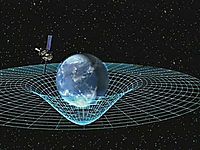
Photo from wikipedia
In this study, an intelligent reflecting surface (IRS)-aided space–time line code (STLC) system is examined to efficiently extend its coverage area. The IRS phase-shift values of each element can be… Click to show full abstract
In this study, an intelligent reflecting surface (IRS)-aided space–time line code (STLC) system is examined to efficiently extend its coverage area. The IRS phase-shift values of each element can be designed using a semidefinite relaxation (SDR) method to maximize the received signal-to-noise ratio of the IRS-STLC systems. A unit-modulus constraint relaxation (UCR) method is proposed to reduce the computational complexity of the SDR method. The numerical results verify that the proposed UCR-based IRS can achieve comparable bit-error-rate performance to the SDR-based IRS, albeit with significantly reduced computational complexity. Owing to the proposed IRS, the coverage area can be significantly extended.
Journal Title: IEEE Wireless Communications Letters
Year Published: 2022
Link to full text (if available)
Share on Social Media: Sign Up to like & get
recommendations!